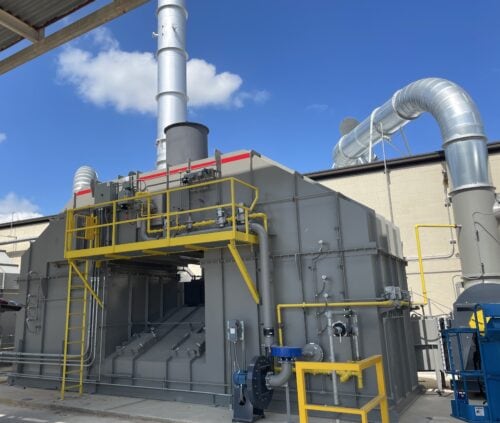The Challenge
As the lithium-ion battery industry grows rapidly, old technology is being replaced with new. Furthermore, the lithium-ion batteries powering electric vehicles (EV’s) will not last forever. Due to degradation, the typical lifespan of an EV car battery is 10-20 years or between 100,000 and 200,000 miles. So, what happens to these batteries when they’ve reached the end of their life?
EV Battery Recycling is a growing market in the US, especially as more batteries will reach the end of life in the coming years. 11.3 Gigawatt hours (GWh) of EV batteries reached the end of life in 2022, with that number projected to rise to 138 GWh in 2030. With the current shortage of domestically supplied battery critical materials, recycling is even more important to provide additional supply sources. One US-based battery recycler is looking to build new facilities and expand their current ones but needed the expertise of Anguil Environmental Systems to ensure a sustainable process.
This company recycles household, industrial, and EV batteries, which all have similar recycling processes. First the batteries are disassembled into smaller units, which are then mechanically separated to recover components. Afterwards, hydrometallurgical treatment recovers the metals and plastics of lithium batteries to be reused in new products. Several steps of this process produce exhausts that need to be treated.
Anguil’s engineers were brought in to design a unique system for the customer that complied with local emission regulations. Their current VOC concentrations were up to 25% LEL (Lower Explosive Limit), but a destruction rate of at least 98% was required. The combination of a saturated process stream with incoming particulate meant that special design considerations needed to be made. These will ensure a long equipment life span and minimize system downtime.
 The Solution
The Solution
These unique challenges lead Anguil’s team to select a Model 300 Regenerative Thermal Oxidizer (RTO). Due to the high moisture content in the customer’s airflow several parts of the system were constructed of stainless steel to provide resistance to corrosion including the process fan, diverter valve assembly, media support section and exhaust stack. An internal coating was also applied to the oxidizer chamber to provide additional protection.
To allow for processing of the spikes in VOC concentrations, a hot bypass duct system was included to bypass chamber gases directly to the exhaust stack, preventing an over-temperature condition from developing within the RTO. Prior to reaching the RTO, the process exhaust will pass through a filter in the upstream ductwork to remove any particulate.
The main process fan was sized to ensure enough inlet suction was available to overcome the planned upstream filtration and ductwork pressure losses. A local control panel near the RTO was to be included within a dedicated prefabricated room to provide protection against weather for personnel when using the panel HMI.
The Result
The RTO was chosen for this application, as it was the most cost-effective solution over direct-fired oxidizer systems and catalytic oxidizer systems. A direct-fired oxidizer would have consumed a high amount of supplemental fuel due to the high flow volume and lower VOC concentrations. A catalytic system was ruled out because of the higher initial cost due to the amount of catalyst required and the cost of periodic catalyst replacement.
As the world transitions to electric vehicles, there is an increasingly crucial need for efficient and sustainable battery recycling. The growing number of end-of-life batteries presents a unique opportunity and challenge for this industry, and Anguil Environmental Systems is ready to step in to address this challenge, providing tailored solutions to ensure a safe and environmentally responsible recycling process. By designing state-of-the-art pollution control systems, Anguil helps our clients meet stringent emission regulations while optimizing the recycling process. Our innovative solutions not only address the immediate needs of the industry but are also paving the way for a more sustainable future, where valuable resources can be recovered and reused, contributing to a circular economy.

